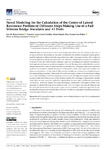Novel Modeling for the Calculation of the Center of Lateral Resistance Position of Different Ships Making Use of a Full Mission Bridge Simulator and AI Tools

Use este enlace para citar
http://hdl.handle.net/2183/38923
A non ser que se indique outra cousa, a licenza do ítem descríbese como Creative Commons Attribution (CC BY) license
Coleccións
Metadatos
Mostrar o rexistro completo do ítemTítulo
Novel Modeling for the Calculation of the Center of Lateral Resistance Position of Different Ships Making Use of a Full Mission Bridge Simulator and AI ToolsAutor(es)
Data
2024Cita bibliográfica
Pérez-Canosa, J.M.; Lama-Carballo, F.J.; Salgado-Don, A.; Cao-Feijóo, G.; Pacheco, E.A.; Orosa, J.A. Novel Modeling for the Calculation of the Center of Lateral Resistance Position of Different Ships Making Use of a Full Mission Bridge Simulator and AI Tools. Journal of Marine Science and Engineering. 2024, 12, 1381. https://doi.org/ 10.3390/jmse12081381
Resumo
[Abstract] Ship maneuvering in ports is increasingly reduced because the increase in ship size is not proportional to the increase in port areas. Furthermore, the number of assisted vessels and the need for tugboats working in densely populated areas make it necessary to reduce the number of involved tugboats, reducing pollution and costs. Therefore, shiphandlers must know, in addition to the pivot point, the center of lateral resistance under any circumstance to optimize the assistance from tugboats and improve maritime navigation. From the literature, it is evident that the practical determination of the center of lateral resistance is still unknown. This paper aims to propose novel mathematical models to identify the position of this point and the most important variables that determine its position. For that, data of different ships in different conditions were obtained from a full mission bridge simulator. Afterwards, 15 novel mathematical models were developed, making use of artificial intelligence tools and training neural networks. The high determination factor reached in some models shows the accuracy of the obtained models. One advantage of the presented models is that they are very easy to be applied by shiphandlers, because highly well-known parameters are involved. Moreover, original 3D charts showing the combination of the input variables were generated to identify the map of the whole process. The very simple new models obtained and the novel 3D charts shown in the present paper can be considered useful and applicable by the shiphandlers of most of the merchant fleet to improve the efficiency and safety of maritime navigation in increasingly restricted waters.
Palabras chave
Full bridge and navigation simulator
Center of lateral resistance
Rate of turn
Mathematical models
Artificial intelligence
Center of lateral resistance
Rate of turn
Mathematical models
Artificial intelligence
Versión do editor
Dereitos
Creative Commons Attribution (CC BY) license






